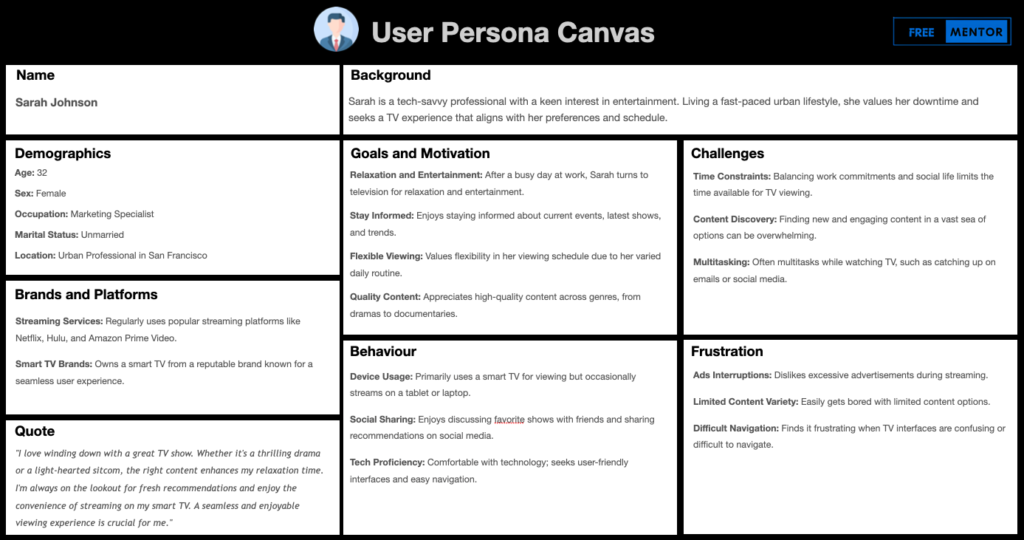
User Persona
“Product management is the intersection of business, technology, and user experience.”
– Des Traynor
Welcome to Day 08 of the PM series – Product Management in 30 days!
User personas are the beating heart of product management. They are the key to understanding your audience, making informed decisions, and building products that resonate with users. This comprehensive post will delve deep into the art and science of creating user personas, exploring their significance, the step-by-step process, and how they drive successful product development.
Learning Objectives
Understanding the Significance of User Personas:
- Learn why user personas are crucial in product management.
- Understand how user personas guide decision-making and resonate with target audiences.
Key Elements of User Personas:
- Explore the essential elements of user personas, including demographics, background, goals, challenges, behavior, and more.
- Recognize how each element contributes to a comprehensive understanding of the target audience.
Creating Effective User Personas:
- Grasp the step-by-step process of creating user personas.
- Learn the importance of thorough research, data collection, and continuous refinement in persona development.
Leveraging User Personas in Product Development:
- Understand practical applications of user personas in product development, such as feature prioritization, design, content creation, marketing strategy, and user testing.
- Explore how user personas enhance user experience and drive successful product development.
Avoiding Common Persona Mistakes:
- Identify common mistakes in creating user personas and understand how to avoid them.
- Emphasize the importance of data-driven decisions and ongoing validation in persona development.
Introduction
User personas, sometimes also called buyer personas or customer avatars, are fictional characters that represent your ideal customers. These personas are based on research and data and help you empathize with your target audience. They are indispensable tools for product managers to guide decision-making throughout the product development cycle.
🤷♂️ Why User Personas Matter?
User personas serve several critical purposes:
- Targeted Marketing: They enable you to tailor marketing efforts to specific audience segments, resulting in more effective campaigns.
- Informed Product Development: User Personas guide product features, design, and functionality. This is based on customer needs and preferences.
- Enhanced User Experience: Understanding your users helps create a seamless and enjoyable experience, increasing user satisfaction and loyalty.
- Improved Communication: Personas foster a shared understanding of the target audience among cross-functional teams.
What are Users personas and their Key elements?
User personas are detailed, semi-fictional representations of your ideal customers. They help understand and empathise with your target audience, guiding product development, marketing strategies, and overall user experience. The key elements of a user persona include:
- Demographics: This includes basic information such as age, gender, occupation, location, income, and education level. Demographics provide a foundation for understanding the context in which your persona operates.
- Background: Insights into the persona’s personal and professional background help to understand their lifestyle, challenges, and preferences. This includes job role, career aspirations, family situation, and educational history.
- Goals and Motivations: Understand what drives and motivates your persona. What are their primary goals, both personally and professionally? This helps tailor your product or service to meet their needs and aspirations.
- Challenges and Pain Points: Identify the obstacles and difficulties your persona faces. Recognizing challenges helps craft solutions that directly address their pain points, making your product more appealing.
- Behaviour: Understand how your persona behaves, both online and offline. This includes their preferred channels for information, communication habits, and general behaviour patterns. Insights into behavior inform marketing strategies and user experience design.
- Preferred Brands and Platforms: Recognize the brands and platforms your persona prefers. This information helps align your product or service with their existing preferences, creating a seamless user experience.
- Tech Proficiency: Assess your persona’s comfort level with technology. This is crucial in tailoring interfaces, features, and communication methods to match their tech proficiency.
- Preferred Content: Identify the type of content your persona consumes, whether it’s specific genres, formats, or mediums. This information is valuable for content creators and marketers.
- Frustrations: Understand the pain points and frustrations your persona experiences. This knowledge is critical for addressing potential issues and improving the overall user experience.
- Quote: A succinct quote in the persona’s voice can encapsulate their attitude or key preferences. It serves as a quick reference point for the team to understand the persona’s perspective.
- Name and Image: Giving your persona a name and a face (even if it’s a stock photo) humanizes them and makes it easier for the team to relate to and remember the persona during discussions.
Effective user personas are built on a foundation of thorough research and can be continually refined as you gather more data and insights about your target audience. They are a valuable tool for keeping the customer at the centre of decision-making processes across various departments.

Download the Free blank User Persona Canvas for your personal use!
Creating User Personas: A Step-by-Step Guide 🪜
Creating user personas involves a systematic approach:
1️⃣ Research and Data Collection
- Start with market research to gather data on your target audience.
- Utilize analytics, surveys, interviews, and customer feedback to collect insights.
- Segment your audience based on common characteristics, behaviours, and needs.
2️⃣ Persona Development
- Based on your research, create distinct personas, giving each a name and a face.
- Include demographic information, job titles, pain points, and goals.
- Flesh out personas with vivid details to humanize them.
3️⃣ Needs and Goals Analysis
- Identify the unique needs, goals, and pain points of each persona.
- Understand their motivations and what drives their decisions.
4️⃣ Behavior and Usage Patterns
- Determine how each persona interacts with your product.
- Identify their preferred channels, devices, and usage frequency.
5️⃣ Mapping the Customer Journey
- Prepare a customer journey map for each persona, illustrating their interactions with your product from discovery to post-purchase.
6️⃣ Validation and Refinement
- Continuously validate personas with real-world data and user feedback.
- Refine personas as your product evolves and your understanding deepens.
Using Personas to Drive Product Development 🏃♂️
Once you have well-defined user personas, you can leverage them in several ways:
- Feature Prioritization: Align product development efforts with the needs and preferences of your personas.
- Design and User Interface: Create designs that resonate with the aesthetics and preferences of your target audience.
- Content Creation: Tailor your messaging and content to address specific personas’ pain points and goals.
- Marketing Strategy: Craft targeted marketing campaigns and advertisements that speak directly to each persona.
- User Testing: Use personas as the foundation for user testing, ensuring your product meets their expectations.
Common Persona Mistakes to Avoid ⚠️
Creating user personas has its pitfalls. Here are some common mistakes to steer clear of:
- Making Assumptions: Rely on data, not assumptions, when defining personas.
- Over-segmentation: Avoid creating too many personas, which can dilute your focus.
- Neglecting Validation: User personas should evolve with your product and customer insights.
🔔 Conclusion
User personas are the compass that guides product managers through the tumultuous seas of product development. They humanize your target audience, making them relatable and understandable. By embracing the art of persona creation and continuously refining it based on real-world data, you set the stage for successful product management and, ultimately, customer satisfaction.
Quiz Time:
Question: Why are user personas considered essential tools for product managers?
A. To increase team diversity
B. To guide decision-making throughout the product development cycle
C. To eliminate customer feedback
D. To create fictional characters for marketing
Question: What are the key elements of a user persona?
A. Only demographics
B. Only goals and motivations
C. Demographics, background, goals, challenges, behavior, and more
D. Only frustrations
Question: What is the purpose of creating a customer journey map for each persona?
A. To increase marketing costs
B. To complicate the product development process
C. To illustrate interactions with the product from discovery to post-purchase
D. To replace user personas
Question: How can user personas be leveraged in product development?
A. By ignoring user preferences
B. By avoiding user testing
C. By aligning product development efforts with the needs and preferences of personas
D. By creating generic designs
Question: What is a common mistake to avoid when creating user personas?
A. Making assumptions instead of using data
B. Over-segmenting personas to increase focus
C. Neglecting validation based on real-world data
D. All of the above
✍️ Write your answers in the comment section. e.g 1-a, 2-b, 3-c etc.
If you want to learn more about product management, you can also find other posts. The Full series is available here
One of the recommended books to learn about product management is The Design of Everyday Things by Don Norman
💌 Do drop me a comment below if you found the content useful and/or want me to write on a specific topic. This will make my day! 🙂
Also, share the post if you think this might help someone. The sharing link is at the top of the page.
Join FreeMentor as a student if you are a newbie in product management and want to have one Free 1:1 mentorship session.
Disclaimer:
Please note that I don’t make any guarantees about the information supplied in this post. I share educational and informational resources that are intended to help you succeed in understanding product management. You nevertheless need to know that your ultimate success or failure will be the result of your own efforts, your particular situation, and innumerable other circumstances beyond my knowledge and control.
#ProductManagement #UserPersonas #ProductDevelopment #UXDesign #CustomerResearch #LinkedInPost

